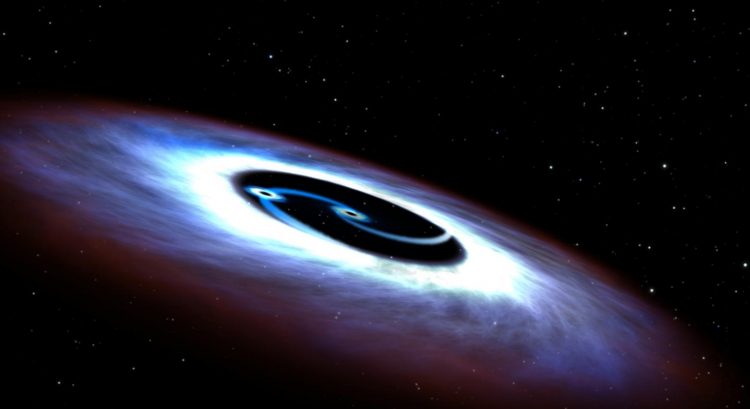OU astrophysicist and collaborators find supermassive black holes in quasar nearest Earth

OU astrophysicist and his Chinese collaborator used observations from NASA's Hubble Space Telescope to find two supermassive black holes in Markarian 231. Credit: Space Telescope Science Institute, Baltimore, Maryland
The discovery of two supermassive black holes–one larger one and a second, smaller one–are evidence of a binary black hole and suggests that supermassive black holes assemble their masses through violent mergers.
Xinyu Dai, professor in the Homer L. Dodge Department of Physics and Astronomy, OU College of Arts and Sciences, collaborated on this project with Youjun Lu of the National Astronomical Observatories of China, Chinese Academy of Sciences.
Dai and Lu looked at ultraviolet radiation emitted from the center of the Mrk 231 from Hubble observations, then applied a model developed by Lu to the spectrum of the galaxy. As a result, they were able to predict the existence of the binary black holes in Mrk 231.
“We are extremely excited about this finding because it not only shows the existence of a close binary black hole in Mrk 231, but also paves a new way to systematically search binary black holes via the nature of their ultraviolet light emission,” said Lu, National Astronomical Observatories of China, Chinese Academy of Sciences.
“The structure of our universe, such as those giant galaxies and clusters of galaxies, grows by merging smaller systems into larger ones, and binary black holes are natural consequences of these mergers of galaxies,” said Dai.
So over time, the two black holes discovered by Dai and Lu in Mrk 231 will collide and merge to form a quasar with a supermassive black hole. A quasar is an active galaxy with an illuminated center, which is short lived compared to the age of the universe.
###
The results of this project were published in the August 14, 2015, edition of The Astrophysical Journal. For more information about this project, please contact Xinyu Dai at xdai@ou.edu.
Media Contact
All latest news from the category: Physics and Astronomy
This area deals with the fundamental laws and building blocks of nature and how they interact, the properties and the behavior of matter, and research into space and time and their structures.
innovations-report provides in-depth reports and articles on subjects such as astrophysics, laser technologies, nuclear, quantum, particle and solid-state physics, nanotechnologies, planetary research and findings (Mars, Venus) and developments related to the Hubble Telescope.
Newest articles

First-of-its-kind study uses remote sensing to monitor plastic debris in rivers and lakes
Remote sensing creates a cost-effective solution to monitoring plastic pollution. A first-of-its-kind study from researchers at the University of Minnesota Twin Cities shows how remote sensing can help monitor and…

Laser-based artificial neuron mimics nerve cell functions at lightning speed
With a processing speed a billion times faster than nature, chip-based laser neuron could help advance AI tasks such as pattern recognition and sequence prediction. Researchers have developed a laser-based…

Optimising the processing of plastic waste
Just one look in the yellow bin reveals a colourful jumble of different types of plastic. However, the purer and more uniform plastic waste is, the easier it is to…


